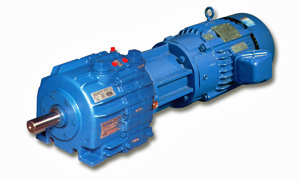
| Archive/Subscribe | TAPPI.org | Advertise | TAPPI Press Catalog | September 2016 |
Long Coupled Clutch/Brakes Reduce Motor Shaft, Keyway Damage
 Posidyne® long coupled C-Face clutch brakes from Force Control Industries, Fairfield, Ohio, USA, are an excellent option for high cycle (50 to 300 cpm) applications because they eliminate the damage to keyways and motor shafts that commonly occur. When indexing with a clutch brake, each clutch engagement transfers a torque spike to the connection between the motor shaft and the input shaft of the clutch brake.
High cycle applications can cause continuous, severe, hammering on the shaft connection of the motor to the clutch brake. For convenience and ease of assembly, a standard C-Face connection is often used. In this arrangement, the motor shaft installs into the hollow bore of the clutch brake input shaft. However, the loose fit required for ease of assembly causes all of the torque to transfer through the key and keyway, resulting is early failure. A coupling that is shrink-fitted or clamped to both shafts for a 360° connection transfers the torque through the shaft and not just the key. The long coupled Posidyne clutch brake offers both the simplicity of C-Face mounting, and the tight fitting coupling.
Posidyne clutch brakes feature oil shear technology that allows rapid and precise stopping, starting, reversing, speed change, and positioning—all without adjustment and virtually no maintenance. Ideal for applications with frequent start/stop cycles, these unique motion control devices allow higher cycle rates (as high as 300 cpm), increased production rates, all while reducing downtime. Higher production rates coupled with significantly longer service life than traditional (dry) clutch/brakes (5 to 10 times longer in many cases) yields increased uptime, and improved productivity. No adjustment, virtually no maintenance, multi-year service life, minimal parts inventory, reduced parts, and replacement ordering cost, add up to higher production at significantly lower maintenance costs.
Designed with low inertia cycling components makes the Posidyne clutch brake more efficient, requiring less motor horsepower to accelerate the load, and less torque to stop the load. Their totally enclosed design is impervious to dust, chips, chemicals, coolants, caustic wash down, weather, and more, making them ideal for hostile environments. They are field proven in diverse applications such as lumber mills, shingle plants, fiberglass insulation production, food processing, packaging, metalworking, and more.
Posidyne clutch/brakes feature a multiple disc design that produces high torque from a small package. Re-circulating the fluid dissipates the heat of engagement, which is a common cause of downtime with other clutch/brake assemblies.
A simple actuation system allows torque in the clutch and brake to be precisely controlled. Adjustment for rapid or soft starts and stops is easily accomplished. Manifold mounted control valves reduce response times by eliminating hoses and fittings, and are recommended for high cycle applications. By reducing the high starting inrush currents and the associated power factor imbalance in the motor, these unique clutch/brakes can also reduce energy costs.
The Posidyne clutch brake can be actuated by air or hydraulic pressure for use in a plant or outside remote applications. The hydraulic actuation package includes a hydraulic pump, solenoid valve, regulators, and a filter. A heat exchanger can be added for additional cooling.
The Posidyne is inherently explosion proof with the addition of an explosion proof actuation valve, or locating the valve in an explosion proof cabinet. Multiple sizes are available to suit particular applications from ½ to 350 HP (99 lb. in. to 79,000 lb. in.) with cooling options, control logic, and mounting arrangements to simplify and speed installation.
Oil Shear Technology is the reason that brakes by Force Control last up to 10 times longer than standard dry friction brakes and do not need maintenance, adjustment, or disc replacement. Oil Shear Technology is the function of a boundary layer of transmission fluid in shear between the friction discs and drive plates. As the parts come together, the fluid in shear will transmit torque between the two parts, as well as absorb heat. This eliminates direct contact of the friction discs and drive plates during high-speed slip. Heat from the friction surface is dissipated as the fluid circulates to the housing.
Heat dissipation is a major component when selecting a clutch brake. The Posidyne clutch brake basic unit dissipates heat through a unique internal design pumping system, which causes the transmission fluid to be drawn into the center of the hub, flows through the friction stack, and by centrifugal force is pulled out of the stack to the housing. Cooling occurs as the fluid flows down the housing walls. Additional heat can be dissipated by adding water-cooling, or pulling the fluid out of the unit for additional heat exchanger cooling and filtration. These cooling options allow the same compact size Posidyne clutch brake to be used on high inertia loads, or in extremely high or low temperatures.
More information is available online.
|


